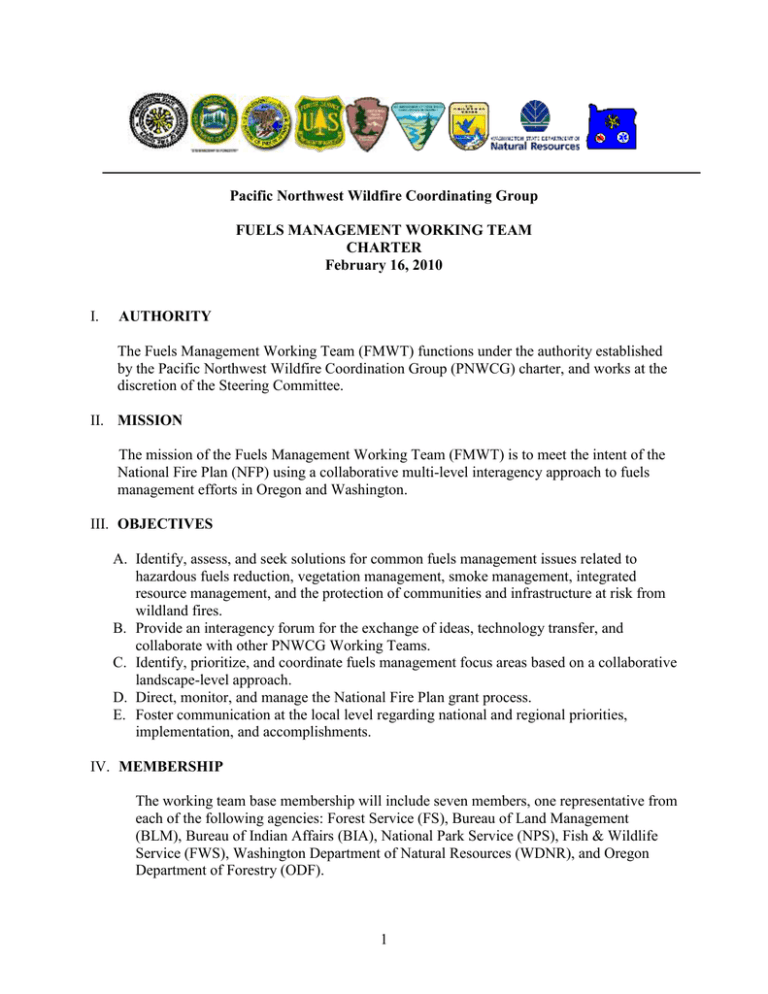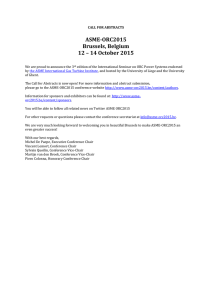I. Pacific Northwest Wildfire Coordinating Group FUELS MANAGEMENT WORKING TEAM
advertisement

Pacific Northwest Wildfire Coordinating Group FUELS MANAGEMENT WORKING TEAM CHARTER February 16, 2010 I. AUTHORITY The Fuels Management Working Team (FMWT) functions under the authority established by the Pacific Northwest Wildfire Coordination Group (PNWCG) charter, and works at the discretion of the Steering Committee. II. MISSION The mission of the Fuels Management Working Team (FMWT) is to meet the intent of the National Fire Plan (NFP) using a collaborative multi-level interagency approach to fuels management efforts in Oregon and Washington. III. OBJECTIVES A. Identify, assess, and seek solutions for common fuels management issues related to hazardous fuels reduction, vegetation management, smoke management, integrated resource management, and the protection of communities and infrastructure at risk from wildland fires. B. Provide an interagency forum for the exchange of ideas, technology transfer, and collaborate with other PNWCG Working Teams. C. Identify, prioritize, and coordinate fuels management focus areas based on a collaborative landscape-level approach. D. Direct, monitor, and manage the National Fire Plan grant process. E. Foster communication at the local level regarding national and regional priorities, implementation, and accomplishments. IV. MEMBERSHIP The working team base membership will include seven members, one representative from each of the following agencies: Forest Service (FS), Bureau of Land Management (BLM), Bureau of Indian Affairs (BIA), National Park Service (NPS), Fish & Wildlife Service (FWS), Washington Department of Natural Resources (WDNR), and Oregon Department of Forestry (ODF). 1 2 The grants subcommitee is a constituent body of the working team. The grants subcommittee consists of four members, with one representative from BLM, FS, WDNR, and ODF. The grants subcommittee members can be the same members identified on the base working team, or additional members representing each of the four agencies. This may be dependent on the agency’s ability to assign additional personnel to serve on the grants subcommitee. Chair: The Chair is responsible for distributing information to the working team and acts as the point of contact to the PNWCG Steering Committee. The Chairperson schedules meetings, develops meeting agendas, facilitates meetings, and initiates required correspondence to meet objectives. The Chair will maintain meeting notes and pertinent correspondence as historic documentation. The Chair will convene meetings at such time and places as deemed necessary by the Working Team. Through the Working Team, the Chair has broad authority to make contacts, assign work on behalf of the Team, and commit such resources as it has available. The Chair may recommend to the PNWCG Steering Committee, the need for further resources and authorities when needed. The Chair will provide an annual accomplishment report to the PNWCG Steering Committee. Vice-Chair: The Vice-Chair serves to support the Chairperson in developing agendas and facilitating meetings, attending other group meetings where working team representation is required, assists with other duties critical to meeting objectives, and posts meeting notes to the PNWCG website. The Vice-Chair serves as an essential backup to the Chairperson, and assumes direct leadership in the absence of the Chair. Members: Members serve as their agency representative to provide agency specific goals, missions, and expectations to help maintain interagency function of the working team. PNWCG SC Liaison: The liaison provides guidance, coaches, and mentors with respect to steering committee expectations of the working team. The liaison will meet with the working team a minimum of one meeting per year. Grant Subcommittee Members: Members serve as their agency representative to provide agency specific goals, missions, and expectations. Members serving on the grant subcommittee would be responsible for reviewing, identifying, implementing, and monitoring the grant programs. V. TENURE Chair and Vice-Chair: The Chair and Vice-chair serve for a one-year term, the vicechair then moves into the chair position, and a new vice-chair is selected based on agency rotation. The tenure term starts and ends in January. If the agency rotation falls to a new working team member’s agency, the rotation will go down the line to the next agency when possible. A member should sit on the team for one year before being considered for the vice-Chair position. The Chair, if amenable and agreed upon by the team, may 3 3 maintain the position for two consecutive years. The Agency rotation schedule is as follows: BLM, FWS, DNR, FS, ODF, BIA, NPS. Team Members: Team members will serve a term of at least two years. VI. DECISIONS When a member is absent, they will assign a representative who can speak for their agency in their place, or designate another working team member to speak for them. The Chair or Vice-Chair will make the call for decisions. A quorum is a minimum of five members from the working team, with one of the five being either FS or BLM, and two of the five being ODF and WDNR. A quorum will need to be present in order to make a decision by consensus. If a quorum is not present, the smaller group will meet to discuss, but not decide on important decisions, until a quorum is present. If a consensus cannot be reached with the quorum group, the Chair or Vice-Chair, will decide if a majority vote should be taken at that time or if further discussion is needed. The grants subcommittee members will have equal say in the decision-making process. Higher-level decisions will be forwarded to the PNWCG steering committee for final determination. VII. MEETINGS and REPORTS A set meeting schedule should be established at the beginning of each Chair’s term, with a minimum of four meetings per year. Additional meetings can be scheduled beyond established dates as necessary, and as determined by the Chair. The Chair will provide agendas in advance to the Team members and the PNWCG liaison. The PNWCG liaison should meet with the team at least once a year. To reduce travel costs, conference calls are acceptable. At least one meeting per year should be face-to-face. In the event that the Chair cannot attend a scheduled meeting, the vice-Chair will be responsible to facilitate the meeting. A note taker for the next meeting will be identified at the end of each meeting. If the scheduled note taker is unable to attend the meeting, he or she is responsible to find an alternate note taker. Agendas and meeting minutes will be distributed and posted to the PNWCG website by the vice-Chair. Development of an annual accomplishment report will be by the Chair and Vice-Chair. The Chair will present a summary of the FMWT accomplishments to the PNWCG Steering Committee at the annual review meeting. 3

